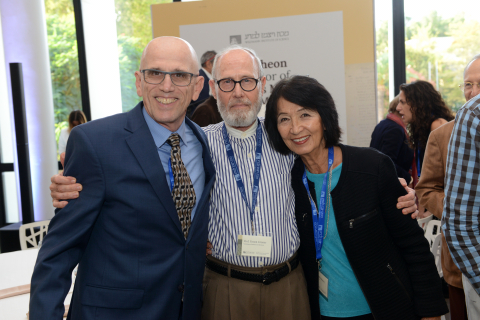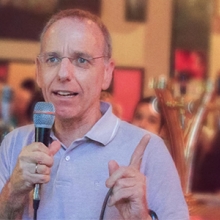Dr. Gladys Monroy and Larry Marks
Reaping and bestowing rewards for scientific research
People behind the science

It’s hard to imagine two more prescient career interests in the Silicon Valley in the 1970s: real estate and intellectual property law with a focus on life sciences. Dr. Gladys Monroy—a molecular biologist with a law degree—and Larry Marks—an investor who saw the building potential as tech giants and start-up companies flowed into the area—indeed both found themselves in the right place at the right time, and their careers reaped rewards.
The couple, who live in Atherton, California, near Palo Alto, have a closely knit friendship with the Weizmann Institute that is grounded in a passion for intellectual curiosity and basic science. Their roles are many: They are active members of the International Board and are co-chairs of the American Committee’s Bay Area region, Gladys is President of the American Committee, and both Larry and Gladys are members of the ACWIS’ Board and its Executive Committee.
As donors and lay leaders, they have spearheaded efforts to develop philanthropic support for the Weizmann Institute and have successfully expanded the circle of Weizmann supporters in their area. Their series of magnanimous gifts to the Weizmann Institute have mainly been earmarked for neuroscience (but not only), including two chairs—a Career Development Chair for Dr. Assaf Tal of the Department of Chemical and Biological Physics who is advancing research on Magnetic Resonance Imaging; and a Research Fellow Chair, held by Dr. Tali Scherf of the Department of Chemical Research Support.
Their latest gift established the Monroy-Marks Integrative Center for Brain Disorder Research, a pillar within the Institute for Brain and Neural Sciences. The new center—which will support disease-related research and provide a link to clinical opportunities across 11 other centers in the new flagship project—is an expansion of a center for neuroscience research they funded in 2017.
“When we initially established this center, we were beginning to see the devastation that neurological diseases including Alzheimer’s, ALS, and Parkinson’s were having on our friends,” says Larry. “We also realized that the brain and its complexities is one of the least understood parts of biological science. In creating the new center under the auspices of this incredibly important institutional project, we know that it will lead to answers that resolve the problems of these diseases.”
“We are committed to the Weizmann Institute today and are big believers in its research, but it might never have happened had I not crossed paths with (Prof.) Yoram Groner 50 years ago,” says Gladys. “We’ve had the great fortune of having nearly a lifetime of hearing and learning about the Weizmann Institute.”
From postdocs to patents
A native of Manhattan born into a family with Chinese and Dutch origins, Gladys grew up in modest means. Her father—who had been sent from China to a U.S. boarding school at age 13—owned a restaurant on the ground floor of their building and her mother was a working professional “and a ‘tiger mom’ before the term even existed,” jokes Gladys.
Her first touch point with the Weizmann Institute of Science came following a PhD in biochemistry, when she met the young Dr. Groner. They immediately hit it off and began brainstorming on joint projects. But their first study together almost didn’t happen.
“It was October 1973, and one day, I came into the lab and Yoram was gone,” Dr. Monroy recalled. Yoram was en route to Israel, having responded to the emergency call for Israel Defense Force reservists to come home; it was the Yom Kippur War. “I tried to keep the research going while he was away, so I needed his notebooks. When I found them, I saw the notes were all in Hebrew and I couldn’t read them,” she recalls. “Luckily, Albert Einstein was affiliated with Yeshiva University, and there were plenty of Hebrew speakers there, and someone translated Yoram’s notes for me.”
Their joint study was published, followed by a series of others. “Working closely with Yoram was my first encounter with the Weizmann name, and through him I understood the high quality of Weizmann science: the special brand of curiosity, ingenuity, and an instinct to collaborate rather than to compete,” she says. “And when he went back to Israel and became a professor at Weizmann, I learned about the way in which new scientists are received, and how they are given all the tools and freedom they need to explore. This kind of freedom—financial and academic—was not even happening in the U.S. at that time.”
In contrast, as a research scientist, she adds, “I spent most of my time writing grant applications. And in order to get funded, I felt the pressure to stick to research avenues that would pass peer review. And in that environment, it’s impossible to do outside-the-box research.”
She has kept in touch with Prof. Groner, now an Extended Service faculty member of the Department of Molecular Genetics, until today.
“When I was called back to Israel during the Yom Kippur War, Gladys, and our mentor, Prof. Jerry Hurwitz, and other lab members looked after my wife Erella and our two boys—a gesture I’ll never forget,” recalls Prof. Groner. “Gladys was a proficient investigator and is a gifted writer who was able to summarize scientific data in a clear manner. These virtues manifested when she became a patent attorney and later a senior partner in one of the largest and highest-rated law firms in the U.S. It was through Gladys that Erella and I later met Larry and immediately became close friends.”
Years later, he continues, “I was thrilled when Gladys and Larry decided to be involved with the Weizmann Institute and became leading members of the Weizmann family in the Bay Area.”
A trajectory to the heart of Silicon Valley
Gladys went on to start her own lab, taking a position as an assistant professor of microbiology at New York Medical College. On a solo vacation in Hawaii, she met Larry, who had been trained as a chemist; sparks flew from the first moment and they talked about science.
Not long after, Gladys moved out to California and they married, and she joined a lab at the University of California, San Francisco. By then it was the early 1980s, and Gladys began to notice two trends in life sciences research: Universities were struggling to receive grants from traditional funding agencies; and scientists began “walking out of the lab with their discoveries,” she recalls, to start biotech companies based on intellectual property (IP) that originated in those labs. “I decided to start exploring IP law and decided to get a law degree, because I wanted to find a way to keep the IP, and some of the monetary windfall from IP, in the hands of academia if that’s indeed where the discoveries were made,” says Gladys.
She received her JD from the University of San Francisco and began practicing patent law in 1986. She made partner in a record-breaking three years, and found the Patent Law Group at Morrison & Foerster LLP. Uniquely positioned as a life scientist with expertise in patent law in the early years of the Bay Area biotech boom, she was hired to work on some of the biggest IP cases of the time and successfully won multi-millions for research universities in litigation. She went on to become president of the Silicon Valley Intellectual Property Law Association, and remains active today on the boards of several biotech companies.
Among her projects, she wrote a patent application on behalf of Chiron Corp. (later acquired by Novartis), whose scientists had discovered the causative agent for Hepatitis C—known until then as ‘non-A, non-B hepatitis’. The scientist who made the discovery, Prof. Michael Houghton, went on to win the Nobel Prize in Physiology or Medicine in 2020, and to develop a blood test for the disease, with Gladys writing the patent for the blood test as well. “I had taught about ‘non-A, non-B’, and it was exciting that someone had discovered the causative agent for it,” she says.
Over the course of her career, she wrote or supervised numerous patents covering breakthroughs in everything from cell-based immunology to blood purification to cancer-gene therapeutics.
Larry, a Chicago native, received his bachelor’s degree in biochemistry and his first job out of college was with Abbott Laboratories, the Illinois healthcare and medical devices company. He went on to get an MBA at the University of Chicago. But the allure of northern California brought him out to the Bay Area in the late 1960s—just before it was tagged with the epithet Silicon Valley. “It was orchards and pastures where horses were grazing,” says Larry. Hewlett Packard, one of a small handful of tech firms to put down roots there, had just bought a chemical company and it needed a chemist to join its ranks. Larry took the job.
Soon the real estate market began to boom, and he found his calling; he left the research bench and turned his focus to buying and selling properties in what would soon become some of the most expensive zip codes in America.
A confluence of events
Beyond their relationship with Prof. Groner—who Larry calls “the glue that held us close to Weizmann all these years”—a series of subsequent events and experiences brought the couple closer to the Weizmann Institute throughout the years. In 2010, Larry was diagnosed with multiple myeloma, but an experimental combination of therapeutics put him into remission. “There was nothing that happened to me in my life that was more definitive in my thinking about how important scientific research is than the life-saving treatment I received for multiple myeloma,” he says.
Around the same time, he became co-chair of the Moldaw Residences for senior living at the Taube Koret Campus for Jewish Life, where he is a board member, in Palo Alto. “My connection with seniors showed me that despite all the progress in treating cancer, the diseases that scared me the most were brain disorders,” says Larry. Then, they attended the Institute’s Global Gathering in Montreal, in 2012, which, he says, “hooked us on the wonderful community that is the Weizmann global family.” Today, they are starting to plan for the 2024 Global Gathering, which is scheduled to take place in San Francisco—in great part because of their leadership efforts in the Bay Area.
Throughout their giving history with Weizmann, they have consistently sought to zero in on neuroscience research with applicative potential. When they established the Monroy-Marks Integrative Center for Brain Disorder Research, their aim was to fund translational research that would have a pervasive effect across the new brain flagship project, the Institute for Brain and Neural Sciences.
“Our mission in brain and neural sciences is basic research, but at the same time the insights generated from our research is frequently translated into tangible benefit for patients,” says Prof. Alon Chen, Weizmann Institute President and a member of the Department of Brain Sciences. “Gladys and Larry are cherished partners in this quest and, moreover, they took an early step in giving as we formulated this project, which was true leadership by example.”
Says Gladys, “Perhaps what we appreciate most about Weizmann is its special brand of collaboration that I first learned about from Yoram and which, throughout the years, we witnessed ourselves and which is so rare elsewhere. This collaborative spirit on campus is extraordinary and so necessary in science, as in all of life.”
—Tamar Morad

With Dr. Assaf Tal, incumbent of the Monroy-Marks Career Development Chair

Reunion with a dear friend: Larry and Gladys with Prof. Yoram Groner








